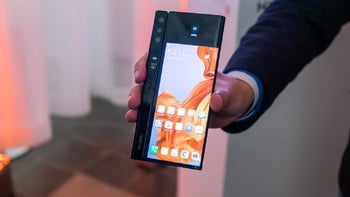Huawei's first foldable has generated nearly $500 million in sales

Last month, Samsung president Young Sohn electrified the smartphone industry when he said that his company had sold 1 million foldable Galaxy Fold units at nearly $2,000 a pop. Samsung later indicated that the figure was incorrect and a couple of days ago at CES, mobile chief DJ Koh said the actual number of Galaxy Fold units sold was in a range of 400,000 to 500,000. That means that the foldable generated nearly $1 billion in revenue for the company.
The other foldable handset available from a major manufacturer is the Huawei Mate X, although it is limited to domestic sales inside China only. According to the company, it has been selling at a rate of 100,000 units per month since its launch in November. The Mate X is priced at the equivalent of approximately $2,450 USD at current exchange rates; if the company's sales numbers are accurate, the Mate X has brought in the equivalent of nearly half a billion dollars to Huawei.
Huawei Mate Xs will feature Humaei Mobile Services and will be sold outside of China
Unlike the inward folding Galaxy Fold, the Mate X folds outward. This means that it sports a 6.6-inch front-screen and a 6.4-inch back screen. When opened, the two displays become a nearly square 8-inch AMOLED display. The device is powered by the Kirin 980 SoC and carries 8GB of memory and 512GB of storage. The camera module on the back is equipped with a 40MP primary camera, an 8MP telephoto camera, a 16MP ultra-wide camera, and a Time of Flight (ToF) sensor. The latter measures the time it takes for infrared light to bounce off of a subject and return to the phone. With this data, more accurate depth information can be calculated for enhanced AR capabilities, more natural bokeh blurs on portraits, and to produce secure 3D maps. A 4500mAh battery keeps the lights on.
Next month at MWC in Barcelona, Huawei is expected to introduce a refreshed version of the phone, the Huawei Mate Xs. This model should be equipped with the Kirin 990 5G chipset that packs more than 10.3 billion transistors in each chip. It also might support a faster 65W charging speed and feature Huawei Mobile Services replacing the Google Mobile Services that the company cannot license because of the U.S. supply chain ban. Huawei will reportedly offer this version of its foldable for sale outside of China giving the firm a shot at an even bigger payoff.

The release of the Motorola razr has been delayed
The delayed Motorola razr was originally expected to be launched on January 9th but was delayed. This seems to be the pattern with foldables as both the Galaxy Fold and Mate X were released months behind schedule. But while those two had issues that needed to be dealt with before they were made available for purchase, Motorola says that it pushed back the razr's release so that it could build more units to meet heavy demand. Some are skeptical about this story, especially since the delay seems to fit the pattern set by Samsung and Huawei's foldable devices. And Motorola has yet to announce a new release date.
The interesting question is whether Motorola will release the razr before February 11th when Samsung is expected to unveil its next foldable phone, the Galaxy Bloom. This device will also close around the horizontal axis like the razr and could be marketed toward female consumers. The most important thing about this bit of news is that it means the Galaxy Fold 2 will most likely sport a form factor similar to the Galaxy Fold. It is expected to sport flagship specs similar to the OG model but could be equipped with a real glass display.










Things that are NOT allowed: